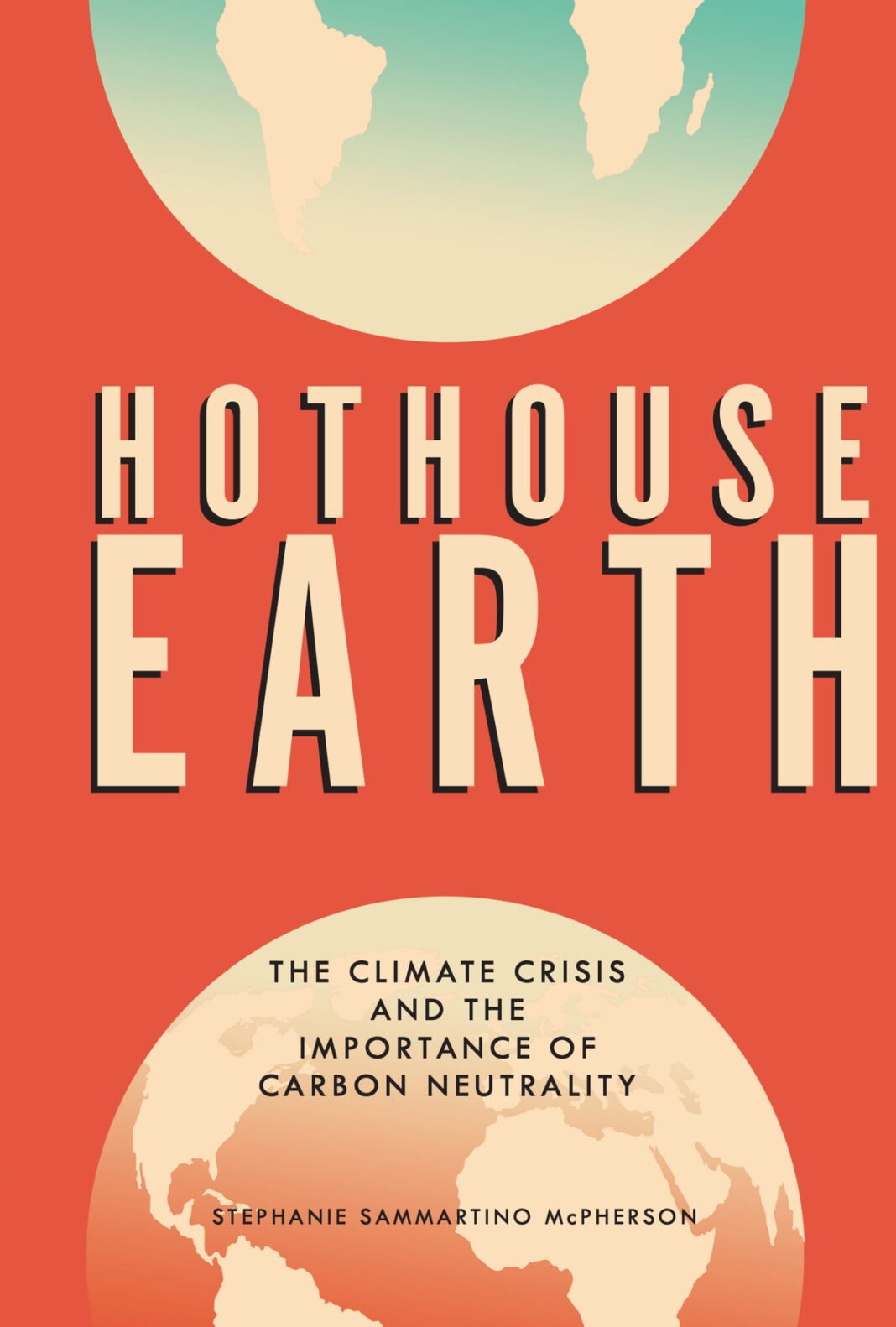What I mean by hothouse Earth, then, is not an ice-free planet, but a world in which lethal heatwaves and temperatures in excess of 50°C (122°F) in the tropics are nothing to write home about; a world where winters at temperate latitudes have dwindled to almost nothing and baking summers are the norm; a world where the oceans have heated beyond the point of no return and the mercury climbing to 30°C+ (86°F+) within the Arctic Circle is no big deal.
==========
Most notable was a cold snap known – somewhat uninspiringly – as the 8.2ka event (‘ka’ being shorthand for ‘kilo-anni’ or thousands of years, because it happened that long ago). The cause was the catastrophic emptying of a huge and expanding glacial lake in North America into the North Atlantic. The shock of an influx of some 160,000 cubic kilometres of cold freshwater raised sea levels by up to 4 metres almost overnight and slowed or stopped the Gulf Stream, triggering a centuries-long spell of cooling. Temperatures fell by as much as 5°C in some parts of the world, bringing to parts of Asia and Africa drought conditions that may have lasted for centuries. While extreme drought is never welcome, in this case it seems – as far as societal development is concerned – to have been a blessing in disguise. This is because it looks as if the paucity of water may have encouraged the development of irrigation in ancient Mesopotamia and the bringing together of people in larger social groupings to cope better with food scarcity. The timing certainly seems to jibe with demographic changes across the region that involve the growth of bigger communities.
==========
Altogether, it is estimated that the prehistoric switch from a hunter-gatherer lifestyle to one of relatively sedentary farming resulted in a global average temperature hike of a shade under 1°C, and perhaps up to 2°C at high latitudes. Considering that the entire population of the planet at the time may have been just 5 million or so, this is an extraordinary feat. It also throws into stark relief the potential climate mayhem we can wreak with an early 21st-century population just shy of the 8-billion mark.
==========
As noted previously, carbon dioxide levels in the atmosphere peaked at a little under 420 ppm in 2021, up 50 per cent on Arkwright’s time, and the highest concentration for around 15 million years. Unless drastic action is taken to reduce emissions, we can expect the level of carbon dioxide in the atmosphere to reach 560 ppm – twice the pre-industrial concentration – by the 2070s, or even earlier, bringing the prospect of severe and sustained hothouse conditions on our planet.
==========
It is no surprise that heatwaves have become more intense and are lasting longer. As a hotter atmosphere contains more water in the form of vapour, rainfall across the land has increased as our world has heated up, and more rain is falling as intense downpours so that the incidence of serious flooding is rising too. Storm tracks have migrated towards higher latitudes, while heating of the oceans has increased their potential to spawn and drive more powerful hurricanes. Hotter seas are also taking their toll on coral reefs, and on land many species are struggling to keep up with the relentless poleward march of climate and vegetation zones at up to 10 kilometres a year, as temperatures at a particular latitude rise ever higher. This is leading to enforced migration and dietary changes, breeding issues, problems with pollination and – in many cases – diminishing numbers.
==========
Since the middle of the 20th century, the northern hemisphere summer has increased in length from 78 days to more than 95. By the end of this century, summers here are forecast to last half a year, with the duration of winter slashed to just eight weeks.
==========
Many, if not most, of the 70,000 deaths arising from the baking summer of 2003 occurred in cities, where the old and vulnerable were unable to escape the heat, and where night-time temperatures in some places did not fall below 24°C.
==========
Worst affected will be those living in cities where the ‘urban heat island effect’, sustained by the expanses of concrete and asphalt, pollution, lack of vegetation and waste heat from human activities, can amplify temperatures by several degrees.
==========
Even people used to heat, for example, agricultural workers in the tropics, would not be able to carry out normal activities at a WBT of 31°C (88°F), which would actually feel like 50°C (122°F). The US National Weather Service regards a WBT of 31°C as representing extreme danger to humans and warns that the failure to take immediate precautions could result in serious illness or even death. The latest dire forecasts predict that with a 2°C global average temperature rise, more than 1 billion people will be affected by such extreme heat stress – this figure rising to fully half the world’s population with a rise of 4°C.
==========
Things start to get even nastier at a WBT of 35°C (95°F), which would correspond to a heat index temperature of a staggering 70°C (158°F), although the index does not actually go this high, not yet at least. This flags the onset of a heat and humidity combo at which the human body can no longer cool itself down through sweating. This means that someone in the shade, even if they are young and fit, even with access to as much water as they want, would be unlikely to survive for more than six hours or so. Normal body temperature is 37°C, but if the body is unable to lose heat, then this core temperature will just keep rising, ultimately resulting in organ failure and death. Climate models have forecast that the first WBT 35°C humid heatwaves will not happen until the middle of the century, at the earliest. Recent research, however, has revealed that these conditions have already been achieved in the Persian Gulf.
==========
Sometime during the later decades of the century, millions of people, including in the major cities of Lucknow (Uttar Pradesh) and Patna (Bihar) are predicted to face at least one WBT 35°C heatwave, bringing the prospect of massive death tolls. Furthermore, more than 1.2 billion people will be exposed to WBT 31°C heatwaves, especially those farming in the Indus and Ganges valleys.
==========
In Brazil’s Amazon rainforest, between August 2020 and July 2021, an area bigger than Cyprus was destroyed, much of it by intentional burning.
==========
One serious concern, looking ahead, is that climate breakdown looks as if it will exacerbate weather phenomena known as atmospheric rivers. These are long, narrow belts of air that together carry more than 90 per cent of the moisture from the tropics into temperate and polar regions. Each ‘river’ acts as a conveyor belt capable of transporting a greater flux of water than the Amazon, which can bring very heavy rain to a particular region that can last for days on end, saturating the ground and driving dangerous flooding. Atmospheric rivers are common enough climate features, with perhaps a dozen or so active across the planet at any one time.
==========
Looking ahead, then, increasingly destructive and deadly flooding is set to become one of the most obvious signatures of global heating.
==========
In the UK, both winters and summers are already around 12 per cent wetter than over the period 1961–1990, and the amount of rain falling on extremely wet days has climbed by 17 per cent compared to the same period. Without significant emissions cuts, winters are set to be almost a third wetter by 2070, and summers close to 50 per cent drier. The latter figure is a little misleading as much of the reduced summer precipitation will take the form of torrential downpours during thunderstorms, raising the potential for severe flash flood events in the hotter months.
==========
The severe drought conditions affecting Lake Mead are the worst in more than 1,200 years and stretch across three-quarters of the western United States. The Colorado River system itself, upon which one in ten Americans depend for at least some of their water, is now flowing at just half its normal capacity. What is happening in the south-western United States is a reminder that, while it is true that a hotter world is also a wetter one, this is a general rule that does not apply everywhere. Higher temperatures, unsurprisingly, also drive an increase in arid conditions so that extreme, prolonged drought and the expansion
==========
What is happening in the south-western United States is a reminder that, while it is true that a hotter world is also a wetter one, this is a general rule that does not apply everywhere. Higher temperatures, unsurprisingly, also drive an increase in arid conditions so that extreme, prolonged drought and the expansion of deserts are only to be expected.
==========
As is happening in the south-western United States, land can become locked into an inescapable cycle of extreme heat, drought and wildfire, ultimately leading to unliveable conditions that drive outward migration. This is something that will become far more common in a hotter world, notably in those areas where drought conditions are predicted to become ever more severe, including Southern Europe, Australia, Central Asia, the United States, Central and South America and most of Africa.
==========
As hurricanes feed off ocean heat, it seems inevitable that as the sea warms at higher latitudes, hurricanes will be able to edge ever further northwards. The worry is that more and more will follow a similar track to Ophelia and make it to the UK and Europe while still maintaining hurricane characteristics and wind speeds.
==========
There is a suggestion that as some parts of the world become unsuited to growing a particular crop, others may become more amenable. This is plain wrong. For example, in coming decades, rising UK temperatures and reduced frosts may appear – at first glance – to make the country more suited to growing grapes. In reality, however, anyone who tries to do so will need to battle a cocktail of increasing extreme precipitation, flooding, heatwaves, drought and new pests. As far as agriculture is concerned, there are no winners in the global heating game. Everyone loses. As heat, drought and crop failures drive people from their homes and off their land, the numbers of economic migrants are for
==========
By 2050, more than 250 million people could be on the move across sub-Saharan Africa, South Asia, Latin America and elsewhere, having been forced on to the road by climate breakdown. Twenty years later, fully a fifth of the Earth’s land area may be effectively uninhabitable, provoking even higher numbers of migration.
==========
In its sixth assessment report, the IPCC forecast that, by 2100, sea level will most likely be around a metre higher than it is today, which is sufficient to affect the lives of hundreds of millions of people. But the true picture could easily be far worse. As the IPCC acknowledges, and a number of other studies support, it is perfectly possible that the rise in sea level by the century’s end could be double this, maybe even more.
==========
While the average stretch of coastline, therefore, experiences a sea level rise of around 3 millimetres per year, a coastal resident, on average, is faced with an annual sea level rise of 8–10 millimetres – pretty much double the average rate. This is because many live in cities built on river deltas, for example, Shanghai, Jakarta and New Orleans, which are subsiding due to water extraction from the underlying sediment. Jakarta, the Indonesian capital, is sinking at 10 centimetres a year – twenty times the rate of global average sea level rise, while New Orleans has already sunk so much that half of it is now below sea level and only protected by sea walls and levees.
==========
So, instead of being one of the world’s most important carbon sinks, the Amazon rainforest is now a source, adding a billion tonnes of carbon dioxide to the atmosphere every year. With higher temperatures and drier conditions driving more wildfires, and no sign of an end to illegal logging, this is a contribution that will inevitably rise.
==========
Pavlof is a coastal volcano that prefers to erupt in the autumn and winter, the reason being that weather conditions push up regional sea level at these times of the year. The rise is temporary and amounts to little more than 15 centimetres – about the span of an outstretched hand. Nonetheless, the additional water load on one side of the volcano causes the crust beneath to bend, squeezing out any available magma like toothpaste out of a tube.
==========
By the end of the century, rainfall across the region could be down by a quarter, contributing – in Mali alone – to a fall in agricultural capacity of 30–40 per cent. Without sufficient food or water, and plagued by violence, it is difficult to see how anything can prevent the Sahel from developing into a string of failed and depopulating states as the world continues to heat up. In Burkina Faso, 5 per cent of the population – around a million people – were forced to leave their homes in 2020 and this is likely just the beginning of an historic exodus.
==========
There is no easy way to say it, but the world of our children and their children will be a far more perilous one. As resources and habitable land diminish, nations will turn against one another in an effort to maintain or gain what they feel is their share and their right. As economies degrade, the social fabric begins to fray and mass migration becomes a global phenomenon, so the election of populist leaders promising the Earth is likely to become increasingly commonplace. At a time when the need for stable and sensible governance will never have been so critical, many countries could be led by unqualified premiers for whom posturing and sabre-rattling replace discourse and cooperation. This is nothing less than a recipe for war, and nowhere is the risk higher than between those South Asian and South-east Asian nations that depend for water and irrigation upon the great rivers that drain the Hindu Kush Himalaya mountains.
==========
Even as climate migrants from African nations arrive in increasing numbers in Southern Europe, so future blistering heat, widespread drought and crop failures will likely drive a permanent movement of people north from Greece, southern Italy and Spain.
==========
Pretty much everywhere in the world, the arrival, in large numbers, of climate migrants is certain to stoke hatred and grow support for anti-migration populist politicians, parties and regimes.
==========
Our world’s population is not rising as fast as it was. Nonetheless, it is predicted to peak at between 9 and 10 billion by the middle of the century, mostly driven by growth in majority world countries in Africa and Asia. This is the very worst news, because at the same time a medley of higher temperatures, water stress and extreme weather is forecast to progressively reduce yields of staple crops. The shortages and price hikes caused by the unprecedented summer of 2021 are forerunners of what is to come, but provide little idea of the scale of future food production problems, which is likely to be devastating.
==========
In fact, since 1960, agricultural productivity has fallen by one-fifth compared to what it would have been in the absence of global heating. This trend will continue as the planet heats up and the area of land available for food production progressively reduces due to excessive temperatures, drought, sea level rise and desertification.
==========
According to the latest forecasts, by 2100, the world’s deserts will have increased in size by 4 million square kilometres – an area larger than India.
==========
As the American writer and journalist Alfred Henry Lewis pointed out in 1906: ‘There are only nine meals between mankind and anarchy.’ Some would say even fewer.
==========
As temperatures continue to rise, the stage is set for decades of progress to control the transmission of insect-borne diseases to be undone, leading to a hike in all sorts of unpleasant illnesses. This will come as a big shock to healthcare systems in many countries, as – according to the World Health Organization – less than half have any sort of national health and climate change strategy in place.
==========
Malaria was only eradicated from the UK after the Second World War, and from Italy as recently as 1970. Mosquitoes remain abundant in both countries and summer temperatures are becoming increasingly conducive to sustaining potential malaria outbreaks.
==========
In a seminal research paper published in 2013, aforementioned ex-NASA climate scientist James Hansen and his colleagues figured out what the outcome would be if we burnt all – or at least most – of the planet’s known fossil fuel reserves, and their conclusion is the stuff of nightmares. Hansen and his co-authors showed that, ultimately, most of the planet would become uninhabitable, largely due to the simple fact that, over much of the Earth’s surface, it would simply be too hot for humans to survive. On average, the planet would heat up by 16°C (61°F), bringing its average temperature to more than 30°C (86°F). Over land, the average rise would be 20°C (68°F), and at the poles a staggering 30°C. Such conditions would be impossible to adapt to and would not only destroy human civilisation but reduce the global population to a tiny fraction of what it is today.
==========
As previously addressed, a quick win can come from rowing right back on methane emissions. Because of its short residence time in the atmosphere, halving emissions by 2030 could reduce planetary heating by a welcome 0.3°C by 2045. But we need to go further. Fossil fuel companies, responsible for leaking around half of all methane emitted by human activities, need to be made – by law – to clean up their act immediately.
==========
Fossil fuel corporations have to be brought to heel, and quickly; the wellheads and coal mines shut down as soon as possible. There is no way the fossil fuel sector is going do this voluntarily, so it must be compelled to leave known oil, gas and coal reserves in the ground, and to stop exploring for more. This can be accomplished via a combination of punitive measures, starting with the scrapping of subsidies. It is infuriating that the same world leaders who talked a good game at COP26 hand over wads of money to the fossil fuel sector in subsidies that, according to the International Monetary Fund, totalled $5.9 trillion in 2020 alone – that’s $11 million every minute. There is no excuse for this, and it needs to stop now, or better still, the subsidies should be switched to the renewables sector.
==========
Emblematic of an economic system that is not fit for the purpose of transforming our society to one that matches the size of our world and its resources is the new rich person’s toy – the spaceship. Weighing in at around 75 tonnes, the emissions expelled by a ten-minute flight on Branson’s Virgin Galactic rocket are equivalent to an entire lifetime’s emissions of one of the poorest billion people on Earth.
==========
One quick way of making a serious dent in emissions would be to take away what seems to be a free pass to pollute from the richest 1 per cent, who were responsible for 13 per cent of emissions in 2013. By 2030, this tiny elite is predicted to pump out 16 per cent of global emissions, 70 tonnes of carbon a year per person, when each of the poorest 50 per cent of the world’s population – those who will bear the brunt of climate breakdown – are responsible for one measly tonne. For comparison, each UK citizen emitted 8.4 tonnes of carbon dioxide in 2021. Looked at individually, the annual carbon footprints of some of the world’s mega-rich are staggering, uplifted to extraordinary levels – nearly 34,000 tonnes in one case – by their monstrous playthings: fleets of high-performance cars, homes on every continent, private jumbo jets, super-yachts and the like.
==========
Our climate is being destroyed by unadulterated, free-market capitalism – an ideology that simply cannot be sustained on a small planet with limited resources. It is a system that has no interest in the greater good and that rewards inordinate capital and the few that have it, rather than the majority who don’t. It cares nothing for the environment or biodiversity and doesn’t give a fig about the fate of future generations. In fact, it is exactly the wrong economic system to have in place at a time of global crisis.





https://www.jarosovi.cz/raptor/
Že to hodně žere? Že to není tzv. rozumné? Vem to čert.
Dříve se lidé, kteří byli v životě neúspěšní (ať už kvůli neschopnosti, lenosti nebo prostě smůle) a kteří záviděli těm úspěšným, stávali komunisty. Dnes už to není moderní, tak přesedlali na klimahysterii / environmentalismus. Argumenty ale zůstaly dost podobné a cíl stejný: vezměte bohatým jejich majetek a dejte ho chudým, tedy přesněji dejte ho mně…